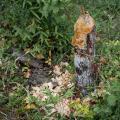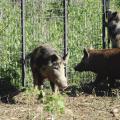Nuisance Wildlife and Damage Management
Wildlife management is often thought of in terms of protecting, enhancing, and nurturing wildlife populations and the habitat needed for their well-being. However, many species at one time or another require management actions to reduce conflicts with people or with other wildlife species. Examples include a biologist trapping an abundant predator or competing species to enhance survival of an endangered species, a farmer excluding deer from an agronomic field that provides a livelihood, or removal of pigeons from a downtown building.
Wildlife damage control is an increasingly important part of the wildlife management profession because of expanding human populations and intensified land-use practices. Along with the growing need to reduce wildlife-people conflicts, public attitudes and environmental regulations are restricting use of some of the traditional tools of control such as toxicants and traps. Agencies and individuals carrying out control programs are being more carefully scrutinized to ensure that their actions are justified, environmentally safe, and in the public interest. Wildlife damage control must be based on sound economic, ecological, and sociological principles and carries out as positive, necessary components of overall wildlife management programs.
Wildlife damage control programs can be thought of as having four parts:
- Problem definition
- Ecology of the problem species
- Control methods application
- Evaluation of control
We must first understand what species is causing the problem, how many are involved, and the amount of loss. We must understand the life history, biology, and behavior of the species. We need to know what control methods are available, including exclusion methods (such as fencing), frightening devices, toxicants, repellents, and harvest. All of these are not options for every species. Generally, combinations of control methods are more effective than use of only one method. This can be termed integrated wildlife damage management.
Mississippi is blessed with abundant wildlife populations, but with these blessings come some problems as well. With a deer population approaching 2 million animals, crops are increasingly being damaged, deer-vehicle collisions are increasing, and even newly established forest are being impacted. Beavers destruction of timber and impoundment levees, fish eating birds impacting the catfish industry, and urban wildlife damage are all on the increase are just a few of the species issues being addressed.
For information about solving problems with wildlife, please see the Prevention and Control of Wildlife Damage Handbook.
Publications
News
Shortly after Emily Duggar bought property in Madison County to build a house near Canton, she realized there were beavers on a creek that ran through the back of the property.
“We saw evidence that beavers were taking down trees and gnawing on trees,” Duggar said. “We could see they were building a dam, and they’ve since built two more dams. The water is rising,” she said. “We haven’t had any flooding yet, but we’ve heard that some people who live in the neighborhoods behind our property have flooding from the creek.”
Success Stories
Trevor Garrett stays busy. He divides his days between farming soybeans with his father, Johnnie Ferrell Garrett, and working as a research associate at Mississippi State University's Pontotoc Ridge–Flatwoods Branch Experiment Station.





